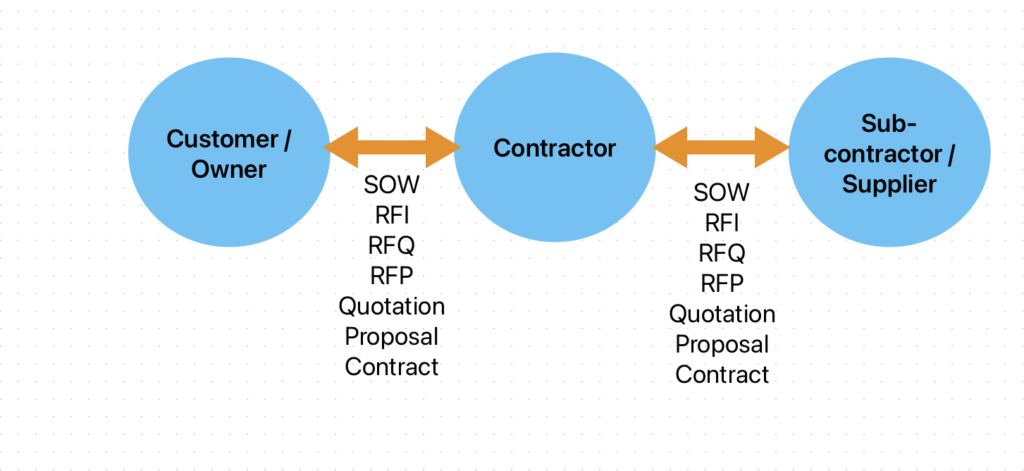
Conducting procurements involves the process of obtaining goods, services, or works from external suppliers or vendors to support the project’s needs. Here’s a structured approach to conducting procurements:
Structured approach to conducting procurements
- Procurement Planning:
- Review the project requirements and determine the procurement needs.
- Identify the goods, services, or works that need to be procured.
- Determine the procurement approach (e.g., competitive bidding, negotiations, sole sourcing).
- Develop a procurement management plan that outlines the procurement strategy, procurement methods, selection criteria, and contract types.
- Vendor Identification and Prequalification:
- Identify potential vendors or suppliers that can meet the project requirements.
- Evaluate vendors based on factors such as experience, capabilities, financial stability, reputation, and past performance.
- Prequalify vendors by conducting vendor assessments, reference checks, and site visits to verify their qualifications and suitability for the project.
- Solicitation of Bids or Proposals:
- Prepare solicitation documents such as request for proposals (RFP), request for quotations (RFQ), or invitation for bids (IFB), outlining the project requirements, evaluation criteria, and submission instructions.
- Distribute the solicitation documents to the prequalified vendors and invite them to submit bids or proposals.
- Allow sufficient time for vendors to prepare and submit their bids or proposals.
- Bid Evaluation and Selection:
- Evaluate the received bids or proposals based on predefined evaluation criteria such as price, technical compliance, quality, delivery schedule, and vendor qualifications.
- Conduct a bid evaluation process to compare and assess the bids objectively.
- Select the winning bidder or proposal based on the evaluation results and award the contract.
- Contract Negotiation:
- Initiate contract negotiation with the selected vendor to finalize the terms and conditions of the contract.
- Negotiate pricing, scope of work, delivery schedules, payment terms, warranties, and other contract terms to achieve a mutually beneficial agreement.
- Document all negotiated changes and agreements in the contract documents.
- Contract Award:
- Award the contract to the selected vendor by issuing a formal contract award notification.
- Provide the vendor with a signed contract agreement specifying the terms and conditions of the contract.
- Ensure that all necessary contract documents are executed by both parties before proceeding with the project activities.
- Contract Administration:
- Monitor the vendor’s performance throughout the contract duration to ensure compliance with the contract terms and conditions.
- Manage contract changes, amendments, and disputes as they arise.
- Track vendor progress, deliverables, and milestones against the contract requirements.
- Review and approve vendor invoices for payment in accordance with the contract terms.
- Contract Closeout:
- Verify that all deliverables and obligations specified in the contract have been satisfactorily fulfilled by the vendor.
- Conduct a final inspection or acceptance of the vendor’s work.
- Close out the contract by finalizing all administrative and financial matters, including final payments, releasing retainage, and obtaining any required closeout documentation.
- Document lessons learned from the procurement process for future projects.
By following these steps, project managers can effectively conduct procurements to acquire the necessary goods, services, or works from external vendors while ensuring compliance with project requirements and achieving value for money.
Tools and techniques commonly used for controlling procurements
- Procurement Performance Reviews: Regularly review the performance of procurement activities against predefined metrics, such as cost, schedule, quality, and vendor performance. Compare actual performance against planned performance to identify variances and take corrective action as needed.
- Variance Analysis: Analyze discrepancies between planned and actual procurement performance to identify the root causes of deviations. Determine whether variations are within acceptable tolerances or require corrective action.
- Change Control Process: Implement a change control process to manage changes to procurement requirements, scope, schedule, or budget. Document and assess proposed changes, evaluate their impact on procurement objectives, and obtain approval before implementing them.
- Issue Logs: Maintain an issue log to track and manage procurement-related issues as they arise. Document issues, including their description, impact, priority, and resolution status. Assign responsibility for resolving issues and monitor their progress until closure.
- Risk Management: Continuously identify, assess, and mitigate procurement risks throughout the procurement process. Develop risk response plans to address potential threats and opportunities that may affect procurement objectives. Monitor risk triggers and implement risk responses as needed.
- Contract Management System: Utilize a contract management system to centralize contract documentation, track contract milestones, and manage contract changes and amendments. Ensure that all contract-related activities are documented, monitored, and reported on regularly.
- Performance Metrics and Key Performance Indicators (KPIs): Define and track performance metrics and KPIs to measure the effectiveness and efficiency of the procurement process. Examples include procurement cycle time, cost savings, vendor performance ratings, and contract compliance.
- Quality Assurance and Quality Control: Implement quality assurance and quality control processes to ensure that procured goods, services, or works meet the required quality standards and specifications. Conduct inspections, audits, and quality reviews to verify compliance and identify areas for improvement.
- Vendor Management: Monitor vendor performance and relationships throughout the procurement lifecycle. Establish clear communication channels with vendors, conduct regular performance evaluations, and address any issues or concerns promptly.
- Escalation Procedures: Establish escalation procedures for addressing procurement-related issues or conflicts that cannot be resolved at the project level. Define escalation paths, roles, and responsibilities for escalating issues to higher levels of management or stakeholders.
- Lessons Learned: Capture lessons learned from the procurement process to identify best practices, areas for improvement, and opportunities for optimization. Document successes, failures, and key insights to inform future procurement activities and enhance organizational knowledge.
